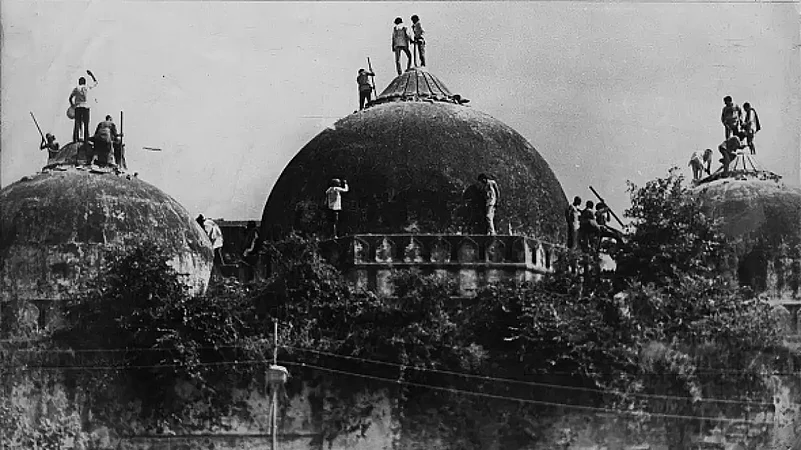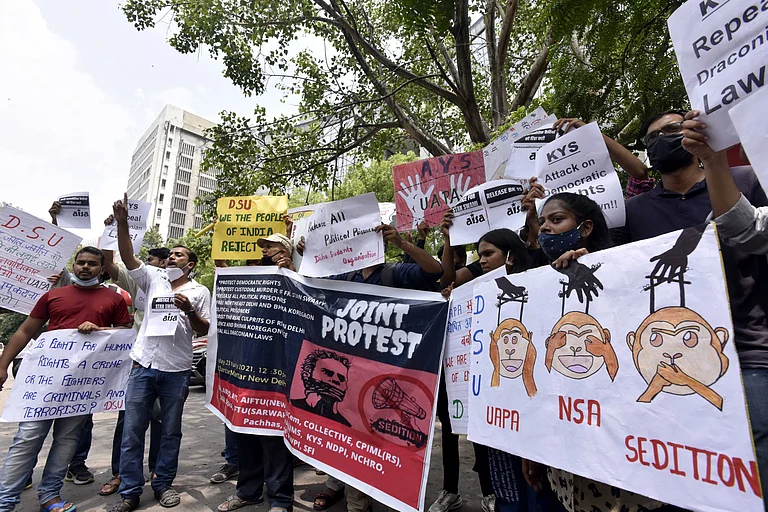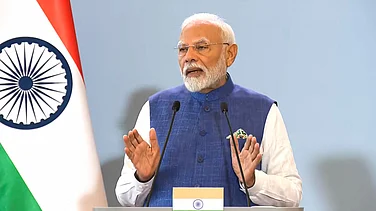December 6, 1992 is a date that has been etched in Indian history such a way that every time debates on secularism appear to shape the political discourse, it comes as a reminder- a warning from the past. If India always had an aspiration to be a secular country, as Prof. Mujibur Rehman points out, it was on that day- with the fall of the dome, it lost all the cherished values. The debris of Babri Masjid wrote a new future for the country where the mind is not ‘without fear’ as Rabindranath Tagore hoped for.
There are loads of researches and literature on what led to the destruction of the grand old mosque. So, while commemorating 31 years of that horrific day treading through the same path is futile. Rather, sitting at a time that in a haunting manner shares the fundamental ethos of early those days, it is prudent to look at the transitions in our moral compass that forever changed the life of our democracy.
Firstly, the major transition that we witnessed in the post-Babri phase pertains to the perception of truth. With the Supreme Court’s crucial verdict in favour of Ram Janmabhoomi, we reached a moment where the scientific truth is pitted against what renowned political anthropologist Thomas Blom Hansen calls ‘emotional truth’. So, the roots of post-truth era can be found far before the intervention of the digital world. The way popular truths were celebrated against the scientific and evidence-based ones someway or other sowed the seeds of a post-truth regime.
Secondly, the sociological believe that the cosmopolitan cities represent diversity where religion and caste seemingly don’t act as deterrence similar to the village society was challenged. The riots in Mumbai and the consequent spatial segregation witnessed across the cities made us recall the Jim Crow era when the cities in the Southern US got sharply divided between white and black, obviously pushing the latter to the ghetto like structures with minimum infrastructure and facilities. It is not to say that the earlier gruesome riots in Ahmedabad and Mumbai didn’t change the landscape of the cities but it was in 1993 that the division became so sharp – stricter than any other moment in history where only ‘culture of suspicion’, as author Radhika Subramaniam calls it, used to determine the limits of social mobility.
The Battles Over Truth
Historian and renowned Professor Harbans Mukhia in his 2017 EPW paper titled, ‘The Fateful Day’ summarised some historical facts that take us back to an initial question- whence the claims of lord Ram’s birthplace exactly at the Babri Masjid’s position started getting strength? Was there any documentation that supported their claims or was it etched in the memory only?
The inscriptions on the inner and the outer wall of the Babri Masjid can be considered as the foremost and fundamental evidence of its construction. A S Beveridge, who translated the memoir of Babur took note of the inscriptions and translated it into two sets. The first reads,
In the name of One who is Omniscient Creator of the Worlds (but) Himself abode-less
In salutation to the Prophet, beyond all praise
The Chief among prophets of the two worlds
Narrating to the world the story of Babur the recluse
Who has attained to the height of worldly success.
While cautioning the readers of not reading much between the lines, Beveridge gave the second set of verses-
By the command of Emperor Babur
whose justice is an edifice reaching up to the very height of heavens
The good hearted Mir Baqi
Built this alighting place of angels
May this goodness last forever
The year of construction becomes manifest in saying
May this goodness last forever.
It clarifies that in the name of Babur, his soldier Baqi constructed the Masjid. However, it no way indicates that a temple was destroyed for its foundation. Babur himself in his autobiography Babur Nama though mentioned that during 1527-28, he visited Ayodhya twice and stayed there for a few days for administrative purpose, he didn’t even bother to mention that he instructed Baqi to found the mosque over a temple.
The next reference of the Ayodhya (Awadh) is found in Abul Faazl’s Ain-I- Akbari written around the last leg of 16th century where though he said that the city was “under the protection of Raja Ramchandra”, no mention of any mosque built on the debris of a temple was noted. As Mukhia rightly points out neither the verses in the Masjid premises, nor in the writings of Babur’s descendants up to Bahadur Shah, any reference to such mosque founded on a destroyed temple could be found. Even Aurungzeb, perceived to be the most bigoted of the lot didn’t refer to such historic event that might have added glory to Mughal regime. “If no one else among the Mughal rulers, Aurangzeb would surely have been pleased to record the act by his great predecessor, if he had heard of it,” notes Mukhia.
The European travelogues of 17th and 18th century also found to be silent on such destruction of any Ram Mandir. However, the first connection of Ram Janmabhoomi to the mosque traced back to 1822 when one Hafizullah in his submission to the Faizabad law court notes, “The Jama masjid, constructed by Emperor Babur, is located at the Janma Asthān, that is at the site of the birth of Ram, son of Raja Dasrat (and is) adjacent to the building of Rasoi (kitchen) of Sita, wife of the above mentioned Ram.”
His reference though mentions the janmasthan of lord Ram, it is certainly silent about the presence of any temple. Throughout the 19th century, it was very difficult to tweak the temple trope to make it a popular truth. In 1870, P Carnegy in his book Historical Sketch of Faizabad District though obliquely referred to the presence of a temple citing the existence of black stone pillars, he was not sure whom to attribute it- Ram or Buddha. In another text, Carnegy said that from the ‘local affirmed’ sources, he got to know that there was an ancient temple.
However, it was in the appendix of Beveridge’s translation of Babur Nama published in 1922 that the Ram Mandir thesis got strengthened. Notably, behind his note that talks about the order of temple demolition lies a presumption that as a follower of Prophet Mohammad (PBUH), Babur must have been intolerant toward other faiths and destroyed the ancient Hindu shrine.
It reads, “Presumably the order for building the mosque was given during Babur’s stay in Aud (Ayo- dhya) in 934 AH [1527–28 AD] at which time he would be impressed by the dignity and sanctity of the ancient Hindu shrine it (at least in part) displaced, and like the obedient follower of Muhammad he was in intolerance of another Faith, would regard the substitution of a temple by a mosque as dutiful and worthy.”
This journey of fact from the days of inscription to the publication of an European translation of Babur Nama shows us how the temple gradually secured its entry into the discourse. Accompanied by the anguish of partition and growing aspiration of a Hindu Rashtra these transitory facts became ‘emotional truths’, believed by many but proved by none.
This smudging of truth easily escaped the meticulous decades’ long scrutiny of the judiciary, as the conscience of the nation was someway or other favouring Ram Janmabhoomi. This debate pushed us to a situation where every scientific truth got questioned. Sometimes Gyanvapi, in other times Taj Mahal become our daily dose of communal diet. Post-truth era starts playing with multiple truths and the evidence turns subjective. Babri Masjid demolition pushed us to a situation where we can’t see truth without prejudice. The only question lies in front of us- Is there really any truth anymore?
In the Debris of Intolerance
Interestingly, the mosque demolition in Uttar Pradesh brought in severe tensions in the streets of Mumbai. As per the media reports, within next four days of the demolition at least 950 people across country had been killed. Most of them were Muslims and in Mumbai, much of them succumbed to the police firing. On December 10, the government decided to ban RSS, VHP and Bajrang Dal for their provocative speeches that led to Babri demolition. As a balancing measure it also banned two Muslim organisation as well. The ban was lifted nonetheless in less than six months.
However, the situation got out of hand on January 6, 1993 when Bane family along with their neighbours were burnt alive at Gandhi chawl in Jogeshwari. Shiv Sena and its right-wing allies used those killings as the weapon to orchestrate further attacks. In the next six days, Thomas Blom Hansen notes, at least 900 people had been killed and around 100,000 people left the city with a promise to never come back. The violence was so brutal that Shiv Sena’s mouthpiece Saamna on January 11, 1993 even appealed to call it off with a headline “Enough is Enough”.
Though it never became clear who killed the Banes, as SC in 1998 acquitted all the 11 accused in the case due to ‘shoddy investigation’ and incredible eyewitness accounts, it was exploited by the political parties in the best possible ways. Meena Menon in her EPW paper ‘The Shadow of Violence’ noted how Sudarshan Bane who lost his parents in the gruesome incident recalled meeting one after another BJP-Shiv Sena leaders including Atal Bihari Vajpayee, “without any relief.”
Jogeshwari (East) had always been a sensitive locality but Muslims and Hindus stayed there together for long, divided by a miniscule border. Since 1960s, with the in-migration of different communities made it as Menon notes, “a tinderbox”. Still, it was only after 1993 riots and the following bomb blasts that the people started to create their own ghettos where they would be presumably ‘safe’ at least from the attack of the invaders who might come through the sea shores.
The news of Bane family’s fate and the other brutal incidents spread like a fire across the country. Not only did it offer political dividend to Hindu rights, rather it questioned the cosmopolitanism that had been pride for these metropolitans. It is though wrong to say that the creation of perceivably ‘cchota Pakistans’ across Indian cities was entirely a by-product of the 1993 Mumbai riots and the consecutive bomb blasts; it definitely was the death knell of a multicultural city life.
Babri Masjid demolition led us to a time where rationality is pitted against emotionality; objectivity against multiple subjectivities and the proclaimed cosmopolitanism of big cities against the blatant segregation. As we commemorate 30 years of the demolition, it is no more only a battle of ideas- it has become a struggle for values that once made ‘India’.



























